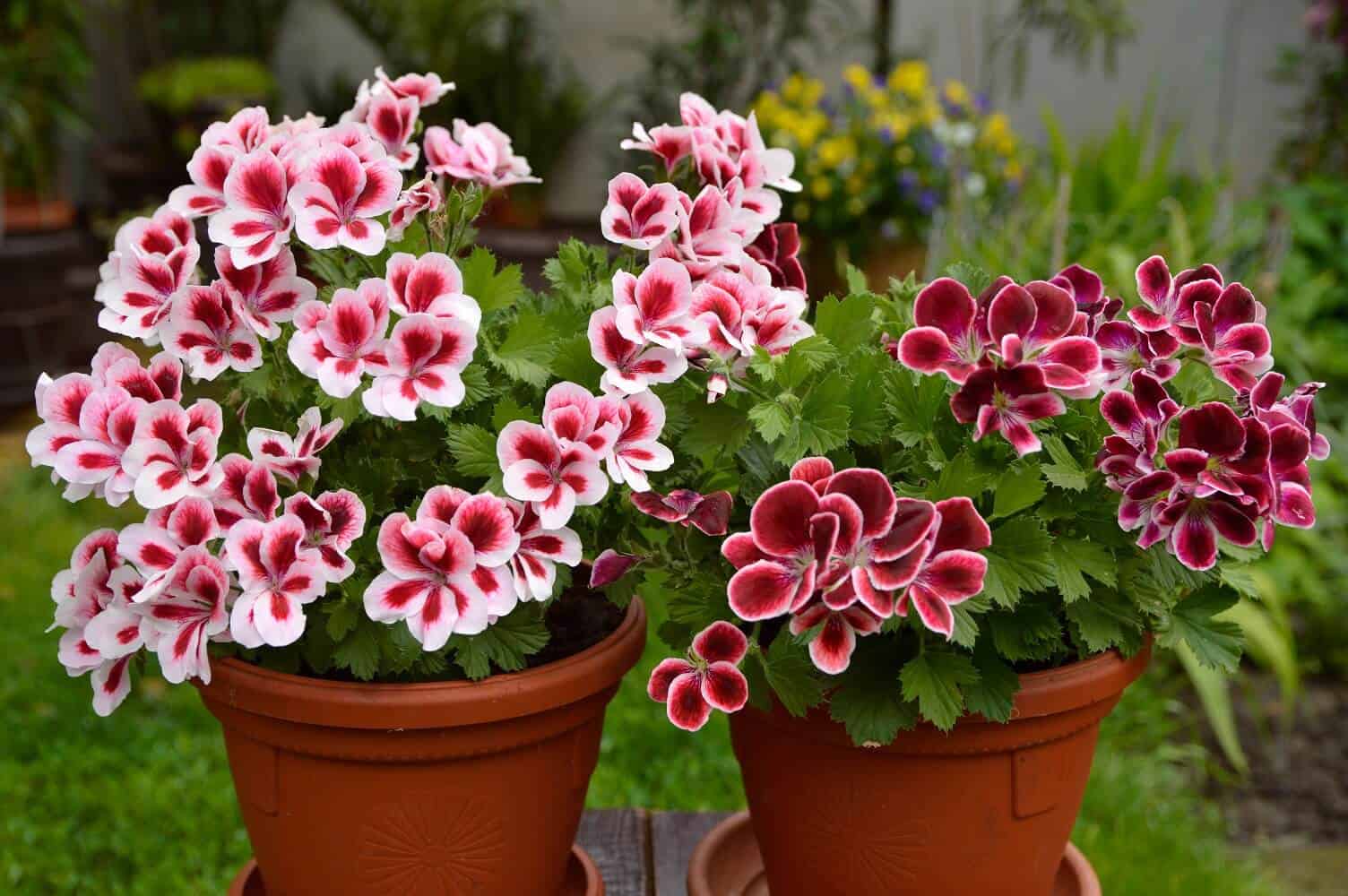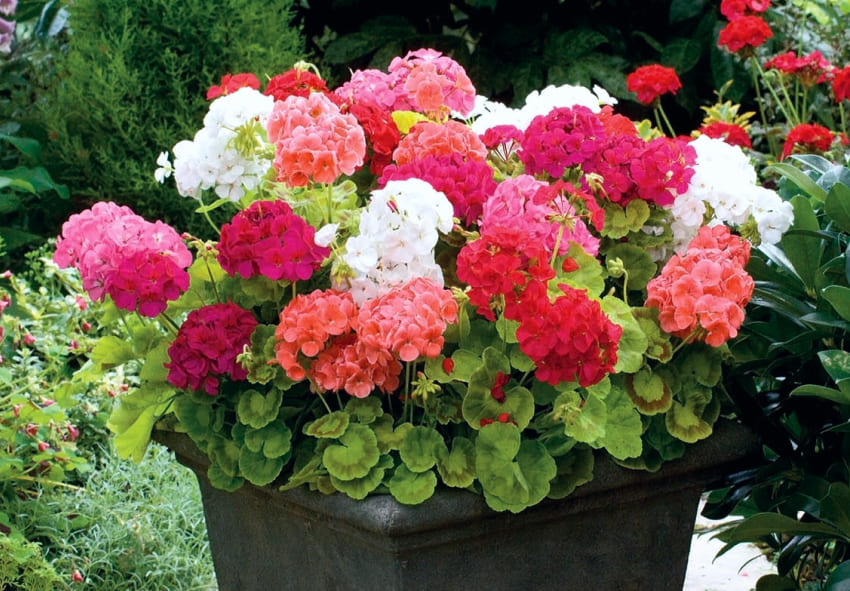The Enduring Allure of Geraniums: A Comprehensive Guide

Geraniums, with their vibrant blooms and distinctive scent, have captivated gardeners for centuries. More than just pretty flowers, they boast a rich history, diverse varieties, and a surprising range of uses, from aromatherapy to culinary applications. This comprehensive guide delves into the world of geraniums, exploring their origins, cultivation, care, and the fascinating properties that make them a garden staple.
A Journey Through Time: The History of Geraniums
The name "geranium" originates from the Greek word "geranos," meaning "crane," a reference to the seedpod’s resemblance to a crane’s bill. However, the plants we commonly know as geraniums are actually members of the Pelargonium genus, while true geraniums belong to the Geranium genus. This distinction, though scientifically important, is often blurred in common usage, and for the purpose of this article, we will focus on the Pelargonium genus, which encompasses the popular garden varieties.
Originally native to South Africa, Pelargonium species were first introduced to Europe in the 17th century. Their exotic beauty quickly caught the attention of botanists and horticultural enthusiasts. By the 18th century, geraniums were being cultivated in European gardens and greenhouses, becoming symbols of elegance and sophistication.
During the Victorian era, geraniums reached the height of their popularity. They were prized for their vibrant colors and ability to thrive in containers, adorning windowsills and balconies. The language of flowers, a popular Victorian pastime, assigned specific meanings to different geranium colors. For instance, scarlet geraniums symbolized comfort, while pink geraniums represented preference.
Over the centuries, through selective breeding and hybridization, countless geranium varieties have been developed, each with its unique characteristics and appeal. Today, geraniums remain a beloved choice for gardeners worldwide, celebrated for their resilience, beauty, and versatility.
Unveiling the Diversity: Exploring Geranium Varieties
The world of geraniums is incredibly diverse, offering a kaleidoscope of colors, forms, and fragrances. Understanding the different types of geraniums can help you choose the perfect varieties for your garden and personal preferences. Here are some of the most popular categories:

Zonal Geraniums (Pelargonium x hortorum): These are the most common type of geranium, characterized by their distinctive "zone" or horseshoe-shaped marking on the leaves. They are known for their upright growth habit, profuse blooms in shades of red, pink, white, and orange, and relatively easy care. Zonal geraniums are excellent choices for borders, containers, and window boxes.
Ivy Geraniums (Pelargonium peltatum): With their trailing or cascading growth habit, ivy geraniums are ideal for hanging baskets and window boxes. Their leaves are glossy and ivy-like, and they produce abundant clusters of single or double flowers in a wide range of colors. Ivy geraniums are particularly well-suited for warmer climates.
Regal Geraniums (Pelargonium x domesticum): Also known as Martha Washington geraniums, regal geraniums are distinguished by their large, showy flowers with ruffled petals. They come in a variety of colors, including rich purples, pinks, and whites, often with contrasting markings. Regal geraniums require more care than other varieties and prefer cooler temperatures.
Scented Geraniums (Pelargonium species): These geraniums are prized for their fragrant leaves, which release their scent when brushed or crushed. The fragrances vary depending on the variety, ranging from rose and lemon to peppermint and chocolate. Scented geraniums are often grown for their aromatic oils, which are used in aromatherapy and perfumery.

Angel Geraniums (Pelargonium crispum hybrids): These delicate geraniums are characterized by their small, intricately shaped leaves and petite flowers. They are known for their compact growth habit and charming appearance, making them ideal for containers and rock gardens.

Cultivating Success: Planting and Caring for Geraniums
Geraniums are relatively easy to grow, making them a great choice for both novice and experienced gardeners. However, providing them with the right conditions and care is essential for ensuring healthy growth and abundant blooms.
Sunlight: Geraniums thrive in full sun, requiring at least six hours of direct sunlight per day. In hotter climates, they may benefit from some afternoon shade.
Soil: Geraniums prefer well-draining soil that is rich in organic matter. A good potting mix formulated for geraniums or a blend of garden soil, compost, and perlite is ideal.
Watering: Water geraniums thoroughly when the top inch of soil feels dry to the touch. Avoid overwatering, as this can lead to root rot. Allow the soil to dry out slightly between waterings.
Fertilizing: Feed geraniums regularly with a balanced fertilizer, especially during the growing season (spring and summer). Follow the instructions on the fertilizer label for proper application rates.
Deadheading: Remove spent flowers regularly to encourage continuous blooming. Pinch off the flower stalks at the base of the plant.
Pruning: Prune geraniums lightly in the spring to promote bushier growth. Remove any dead or damaged stems.
Overwintering: In colder climates, geraniums can be overwintered indoors. Before the first frost, cut back the plants and pot them in fresh soil. Place them in a sunny window and water sparingly.
Beyond the Garden: The Versatile Uses of Geraniums
Geraniums are not just ornamental plants; they also offer a range of practical and beneficial uses:
Aromatherapy: The essential oils extracted from scented geraniums are used in aromatherapy to promote relaxation, reduce stress, and improve mood. Different scents offer different benefits. For example, rose geranium oil is known for its calming properties, while lemon geranium oil is believed to be uplifting and energizing.
Insect Repellent: Geraniums, particularly citronella geraniums, are known for their ability to repel mosquitoes and other insects. Planting geraniums near patios and doorways can help create a more enjoyable outdoor environment.
Culinary Uses: Some geranium varieties, such as rose geranium, can be used to flavor desserts, jams, and teas. The leaves can be infused in sugar or cream to impart a delicate floral flavor. However, it’s essential to use only organically grown geraniums and to ensure they are properly identified before consuming them.
Medicinal Properties: In traditional medicine, geraniums have been used to treat various ailments, including skin irritations, digestive problems, and respiratory infections. However, more research is needed to confirm these potential benefits.
FAQ: Answering Your Burning Geranium Questions
Why are my geranium leaves turning yellow?
Yellowing leaves can be caused by several factors, including overwatering, underwatering, nutrient deficiencies, and pests. Check the soil moisture, fertilize regularly, and inspect the plants for signs of pests or diseases.Why aren’t my geraniums blooming?
Lack of sunlight, insufficient fertilization, and improper watering can all contribute to poor blooming. Ensure your geraniums receive at least six hours of sunlight per day, fertilize regularly, and water consistently. Deadheading spent flowers will also encourage more blooms.How do I propagate geraniums?
Geraniums can be easily propagated from stem cuttings. Take cuttings from healthy stems in the spring or summer, remove the lower leaves, and plant them in moist potting mix. Keep the cuttings moist and warm until they root.Are geraniums toxic to pets?
Geraniums are generally considered non-toxic to pets, but ingestion of large quantities may cause mild gastrointestinal upset.How do I prevent geranium budworms?
Geranium budworms can be a common pest. Inspect your plants regularly for signs of infestation, such as holes in the buds and leaves. Treat affected plants with Bacillus thuringiensis (Bt), a biological insecticide.
Conclusion: A Timeless Garden Favorite
Geraniums have earned their place as a timeless garden favorite for good reason. Their vibrant colors, diverse varieties, and relatively easy care make them a popular choice for gardeners of all levels. From the classic zonal geranium to the fragrant scented varieties, there’s a geranium to suit every taste and garden style. By understanding their history, cultivation requirements, and versatile uses, you can unlock the full potential of these beautiful and beneficial plants, adding a touch of charm and fragrance to your garden and home. So, embrace the enduring allure of geraniums and let their vibrant blooms bring joy to your life.
:max_bytes(150000):strip_icc()/red-flower-pelargonium-zonale-823364782-caceb397ced9406da3e630ade7b04519.jpg)

:max_bytes(150000):strip_icc()/pelargonium-zonale-pink-flowers-with-green-1128714431-2b9b8ad1b0914e0a9aaf1b10a0f43cb5-2e72036bb5b4463691354b4fbcf43511.jpg)